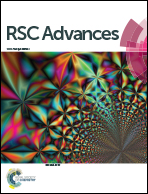Appraisal of Cu(ii) adsorption by graphene oxide and its modelling via artificial neural network
Abstract
Graphene oxide (GO), as an emerging material, exhibits extraordinary performance in terms of water treatment. Adsorption is a process that is influenced by multiple factors and is difficult to simulate by traditional statistical models. Artificial neural networks (ANNs) can establish highly accurate nonlinear functional relationships between multiple variables; hence, we constructed a three-layered ANN model to predict the removal performance of Cu(II) metal ions by the prepared GO. In the present research work, GO was prepared and characterized by FT-IR spectroscopy, SEM, and XRD analysis techniques. In ANN modeling, the Levenberg–Marquardt learning algorithm (LMA) was applied by comparing 13 different back-propagation (BP) learning algorithms. The network structure and parameters were optimized according to various error indicators between the predicted and experimental data. The hidden layer neurons were set to be 12, and optimal network learning rate was 0.08. Contour and 3-D diagrams were used to illustrate the interactions of different influencing factors on the adsorption efficiency. Based on the results of batch adsorption experiments combined with the optimization of influencing factors by ANN, the optimum pH, initial Cu(II) ion concentration and temperature were anticipated to be 5.5, 15 mg L−1 and 318 K, respectively. Moreover, the adsorption experiments reached equilibrium at about 120 min. Combined with sensitivity analysis, the degree of influence of each factor could be ranked as: pH > initial concentration > temperature > contact time.



 Please wait while we load your content...
Please wait while we load your content...